Analysis of Toy Design, STEM Content, and Comparison Project Report
VerifiedAdded on 2021/02/20
|14
|4322
|31
Project
AI Summary
This project report analyzes the design of toys, focusing on specifications, standards, and constraints for children aged 5-7. It involves a comparison of a hydraulic machines kit and a volcanic eruption toy, highlighting their features, safety aspects, and STEM (Science, Technology, Engineering, and Mathematics) content. The report references the Australian Curriculum Year 3, detailing science, design technologies, and mathematics content descriptors relevant to the hydraulic machines kit. The assignment emphasizes the importance of safe toy design, age appropriateness, and the educational value of toys in fostering children's mental growth, curiosity, and learning. The comparison matrix evaluates the educational benefits of each toy, concluding that the hydraulic machines kit provides a more comprehensive STEM learning experience. The report also discusses the application of scientific concepts like hydraulics and chemical reactions, and mathematical concepts such as measurements and calculations. This assignment underscores the significance of teachers' roles in evaluating teaching methods and the integration of toys into learning processes to enhance children's future development.
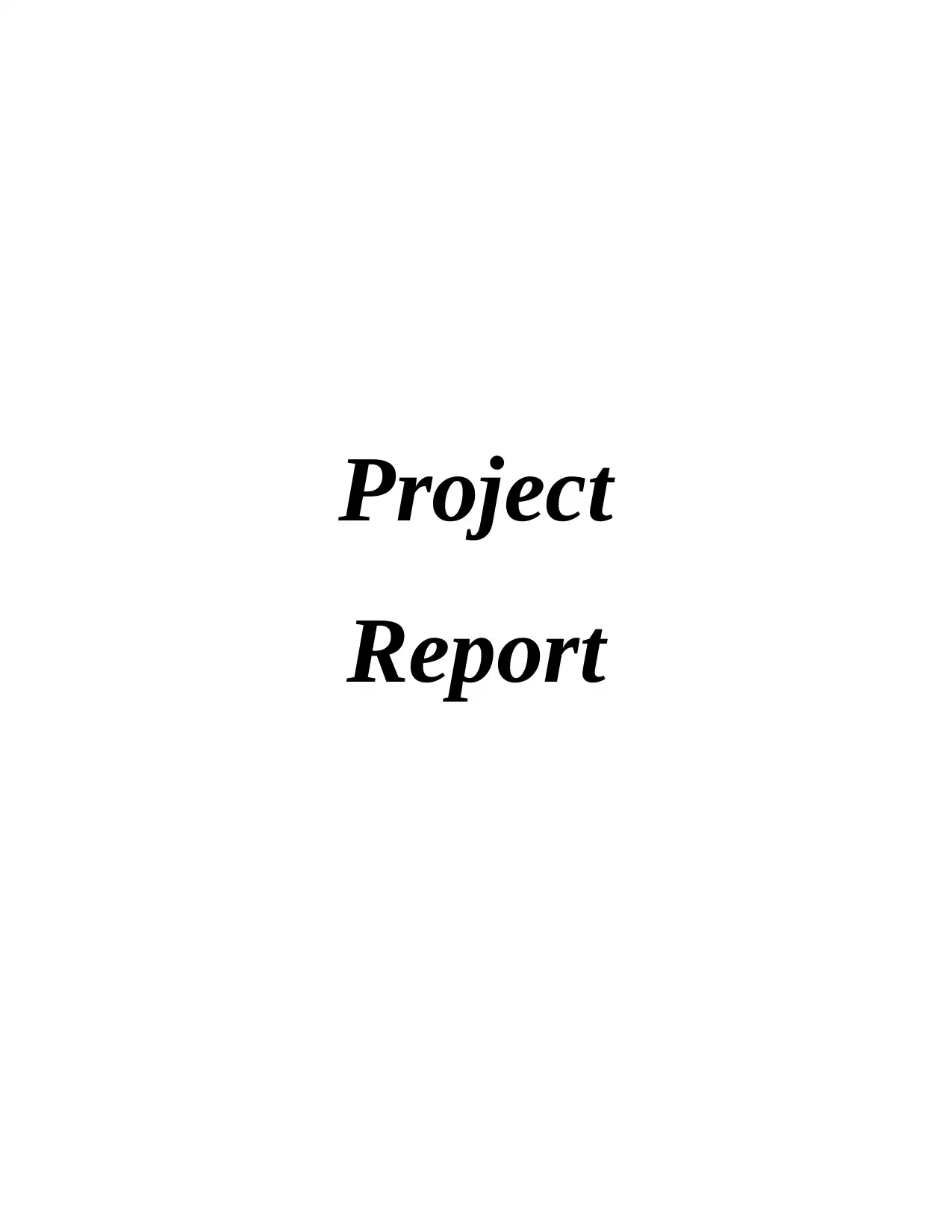
Project
Report
Report
Paraphrase This Document
Need a fresh take? Get an instant paraphrase of this document with our AI Paraphraser
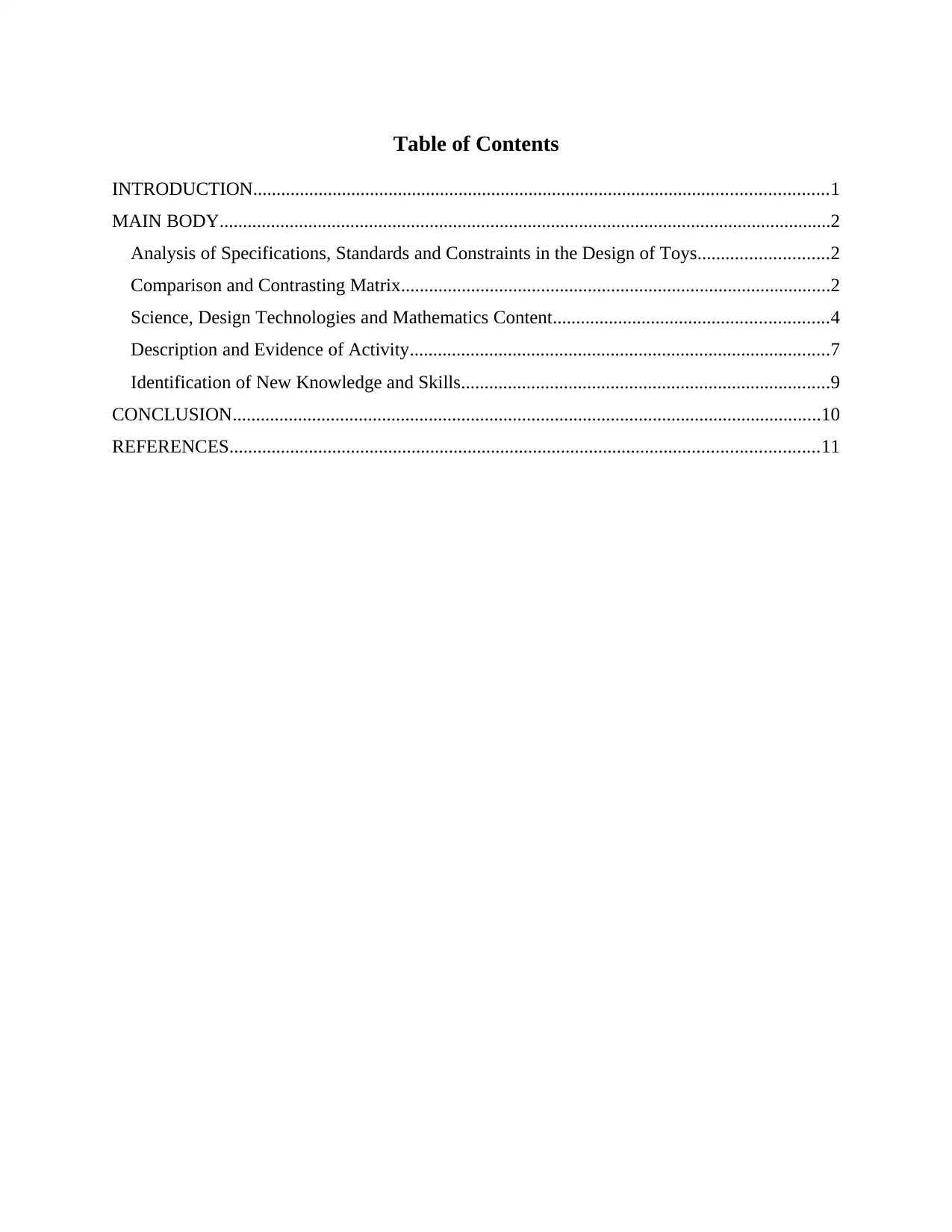
Table of Contents
INTRODUCTION...........................................................................................................................1
MAIN BODY...................................................................................................................................2
Analysis of Specifications, Standards and Constraints in the Design of Toys............................2
Comparison and Contrasting Matrix............................................................................................2
Science, Design Technologies and Mathematics Content...........................................................4
Description and Evidence of Activity..........................................................................................7
Identification of New Knowledge and Skills...............................................................................9
CONCLUSION..............................................................................................................................10
REFERENCES..............................................................................................................................11
INTRODUCTION...........................................................................................................................1
MAIN BODY...................................................................................................................................2
Analysis of Specifications, Standards and Constraints in the Design of Toys............................2
Comparison and Contrasting Matrix............................................................................................2
Science, Design Technologies and Mathematics Content...........................................................4
Description and Evidence of Activity..........................................................................................7
Identification of New Knowledge and Skills...............................................................................9
CONCLUSION..............................................................................................................................10
REFERENCES..............................................................................................................................11
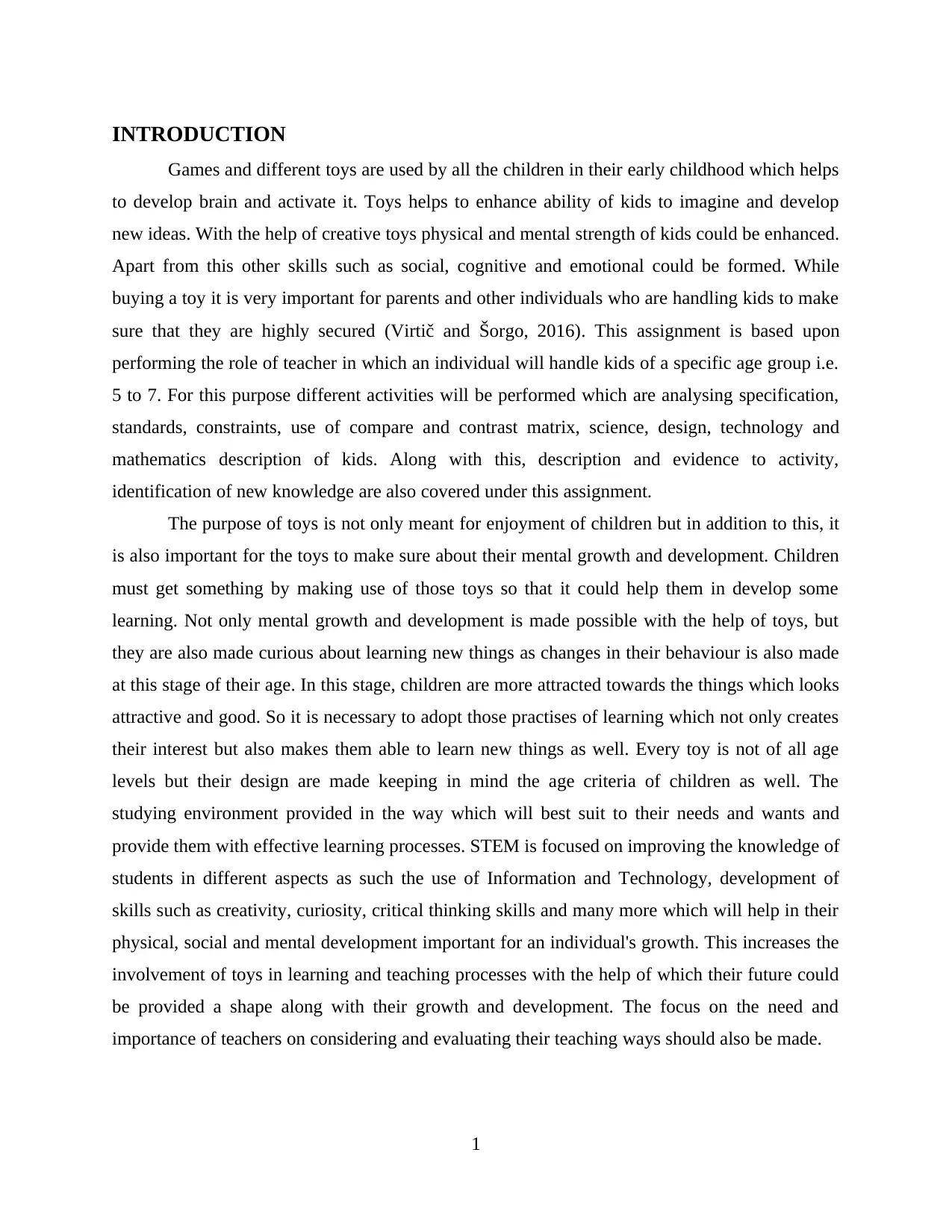
INTRODUCTION
Games and different toys are used by all the children in their early childhood which helps
to develop brain and activate it. Toys helps to enhance ability of kids to imagine and develop
new ideas. With the help of creative toys physical and mental strength of kids could be enhanced.
Apart from this other skills such as social, cognitive and emotional could be formed. While
buying a toy it is very important for parents and other individuals who are handling kids to make
sure that they are highly secured (Virtič and Šorgo, 2016). This assignment is based upon
performing the role of teacher in which an individual will handle kids of a specific age group i.e.
5 to 7. For this purpose different activities will be performed which are analysing specification,
standards, constraints, use of compare and contrast matrix, science, design, technology and
mathematics description of kids. Along with this, description and evidence to activity,
identification of new knowledge are also covered under this assignment.
The purpose of toys is not only meant for enjoyment of children but in addition to this, it
is also important for the toys to make sure about their mental growth and development. Children
must get something by making use of those toys so that it could help them in develop some
learning. Not only mental growth and development is made possible with the help of toys, but
they are also made curious about learning new things as changes in their behaviour is also made
at this stage of their age. In this stage, children are more attracted towards the things which looks
attractive and good. So it is necessary to adopt those practises of learning which not only creates
their interest but also makes them able to learn new things as well. Every toy is not of all age
levels but their design are made keeping in mind the age criteria of children as well. The
studying environment provided in the way which will best suit to their needs and wants and
provide them with effective learning processes. STEM is focused on improving the knowledge of
students in different aspects as such the use of Information and Technology, development of
skills such as creativity, curiosity, critical thinking skills and many more which will help in their
physical, social and mental development important for an individual's growth. This increases the
involvement of toys in learning and teaching processes with the help of which their future could
be provided a shape along with their growth and development. The focus on the need and
importance of teachers on considering and evaluating their teaching ways should also be made.
1
Games and different toys are used by all the children in their early childhood which helps
to develop brain and activate it. Toys helps to enhance ability of kids to imagine and develop
new ideas. With the help of creative toys physical and mental strength of kids could be enhanced.
Apart from this other skills such as social, cognitive and emotional could be formed. While
buying a toy it is very important for parents and other individuals who are handling kids to make
sure that they are highly secured (Virtič and Šorgo, 2016). This assignment is based upon
performing the role of teacher in which an individual will handle kids of a specific age group i.e.
5 to 7. For this purpose different activities will be performed which are analysing specification,
standards, constraints, use of compare and contrast matrix, science, design, technology and
mathematics description of kids. Along with this, description and evidence to activity,
identification of new knowledge are also covered under this assignment.
The purpose of toys is not only meant for enjoyment of children but in addition to this, it
is also important for the toys to make sure about their mental growth and development. Children
must get something by making use of those toys so that it could help them in develop some
learning. Not only mental growth and development is made possible with the help of toys, but
they are also made curious about learning new things as changes in their behaviour is also made
at this stage of their age. In this stage, children are more attracted towards the things which looks
attractive and good. So it is necessary to adopt those practises of learning which not only creates
their interest but also makes them able to learn new things as well. Every toy is not of all age
levels but their design are made keeping in mind the age criteria of children as well. The
studying environment provided in the way which will best suit to their needs and wants and
provide them with effective learning processes. STEM is focused on improving the knowledge of
students in different aspects as such the use of Information and Technology, development of
skills such as creativity, curiosity, critical thinking skills and many more which will help in their
physical, social and mental development important for an individual's growth. This increases the
involvement of toys in learning and teaching processes with the help of which their future could
be provided a shape along with their growth and development. The focus on the need and
importance of teachers on considering and evaluating their teaching ways should also be made.
1
⊘ This is a preview!⊘
Do you want full access?
Subscribe today to unlock all pages.

Trusted by 1+ million students worldwide
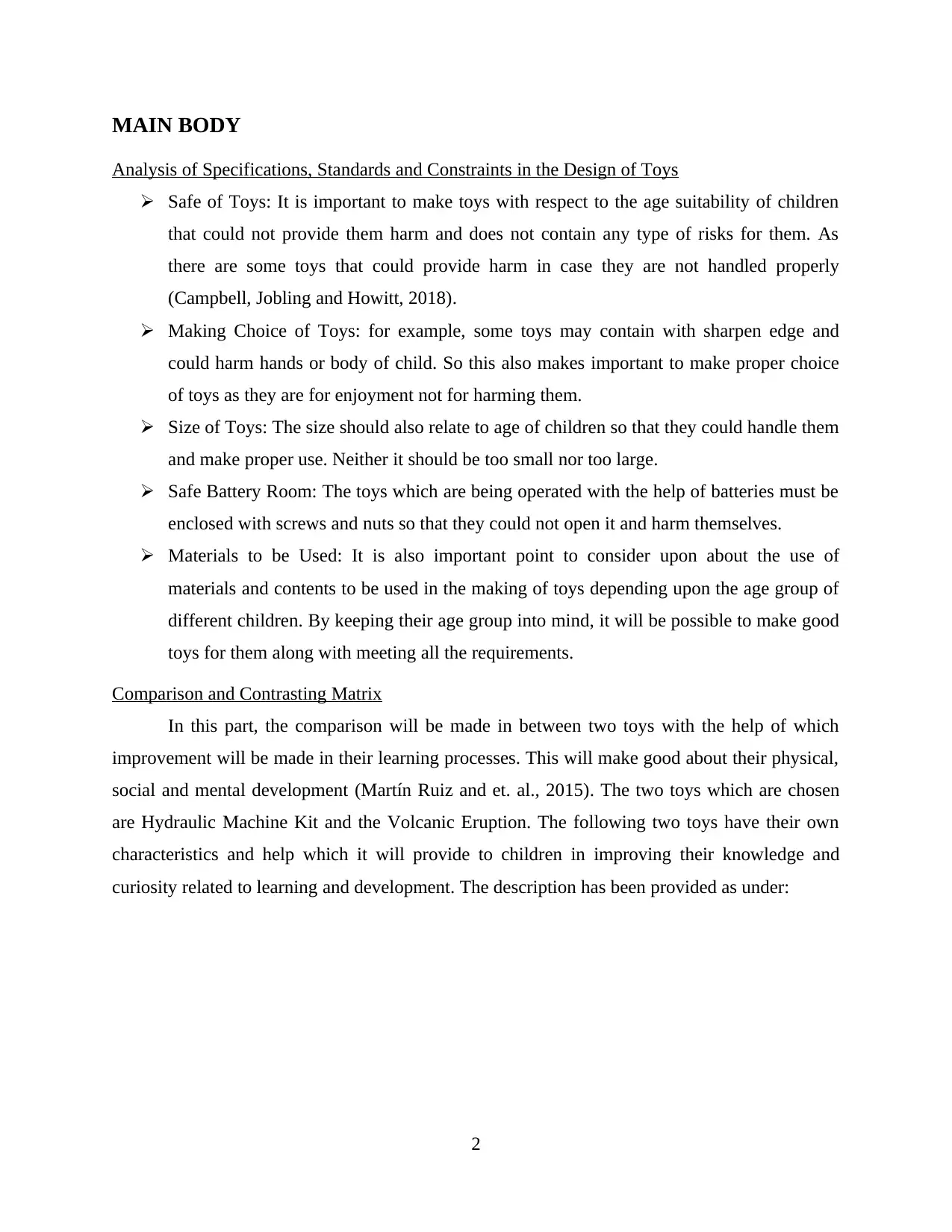
MAIN BODY
Analysis of Specifications, Standards and Constraints in the Design of Toys
Safe of Toys: It is important to make toys with respect to the age suitability of children
that could not provide them harm and does not contain any type of risks for them. As
there are some toys that could provide harm in case they are not handled properly
(Campbell, Jobling and Howitt, 2018).
Making Choice of Toys: for example, some toys may contain with sharpen edge and
could harm hands or body of child. So this also makes important to make proper choice
of toys as they are for enjoyment not for harming them.
Size of Toys: The size should also relate to age of children so that they could handle them
and make proper use. Neither it should be too small nor too large.
Safe Battery Room: The toys which are being operated with the help of batteries must be
enclosed with screws and nuts so that they could not open it and harm themselves.
Materials to be Used: It is also important point to consider upon about the use of
materials and contents to be used in the making of toys depending upon the age group of
different children. By keeping their age group into mind, it will be possible to make good
toys for them along with meeting all the requirements.
Comparison and Contrasting Matrix
In this part, the comparison will be made in between two toys with the help of which
improvement will be made in their learning processes. This will make good about their physical,
social and mental development (Martín Ruiz and et. al., 2015). The two toys which are chosen
are Hydraulic Machine Kit and the Volcanic Eruption. The following two toys have their own
characteristics and help which it will provide to children in improving their knowledge and
curiosity related to learning and development. The description has been provided as under:
2
Analysis of Specifications, Standards and Constraints in the Design of Toys
Safe of Toys: It is important to make toys with respect to the age suitability of children
that could not provide them harm and does not contain any type of risks for them. As
there are some toys that could provide harm in case they are not handled properly
(Campbell, Jobling and Howitt, 2018).
Making Choice of Toys: for example, some toys may contain with sharpen edge and
could harm hands or body of child. So this also makes important to make proper choice
of toys as they are for enjoyment not for harming them.
Size of Toys: The size should also relate to age of children so that they could handle them
and make proper use. Neither it should be too small nor too large.
Safe Battery Room: The toys which are being operated with the help of batteries must be
enclosed with screws and nuts so that they could not open it and harm themselves.
Materials to be Used: It is also important point to consider upon about the use of
materials and contents to be used in the making of toys depending upon the age group of
different children. By keeping their age group into mind, it will be possible to make good
toys for them along with meeting all the requirements.
Comparison and Contrasting Matrix
In this part, the comparison will be made in between two toys with the help of which
improvement will be made in their learning processes. This will make good about their physical,
social and mental development (Martín Ruiz and et. al., 2015). The two toys which are chosen
are Hydraulic Machine Kit and the Volcanic Eruption. The following two toys have their own
characteristics and help which it will provide to children in improving their knowledge and
curiosity related to learning and development. The description has been provided as under:
2
Paraphrase This Document
Need a fresh take? Get an instant paraphrase of this document with our AI Paraphraser
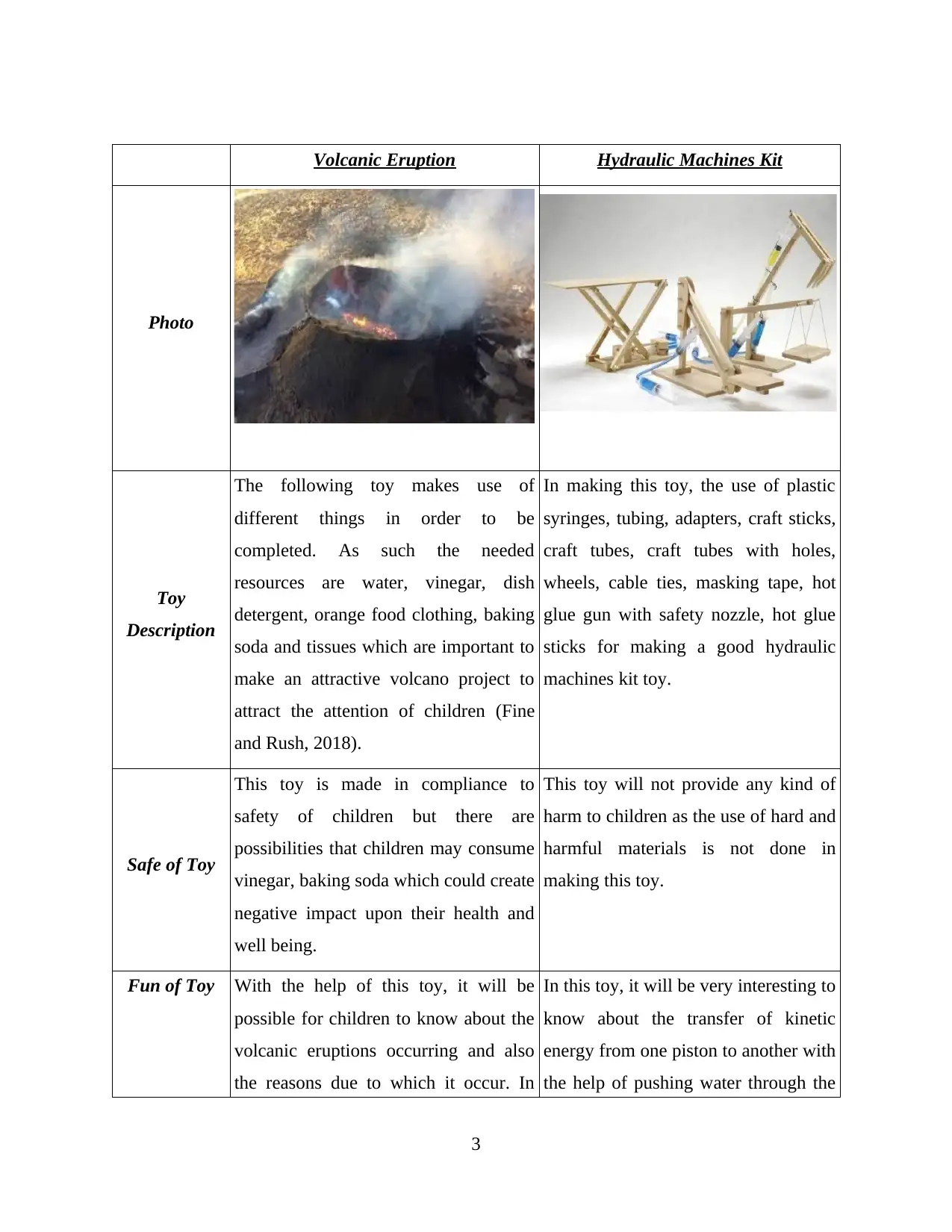
Volcanic Eruption Hydraulic Machines Kit
Photo
Toy
Description
The following toy makes use of
different things in order to be
completed. As such the needed
resources are water, vinegar, dish
detergent, orange food clothing, baking
soda and tissues which are important to
make an attractive volcano project to
attract the attention of children (Fine
and Rush, 2018).
In making this toy, the use of plastic
syringes, tubing, adapters, craft sticks,
craft tubes, craft tubes with holes,
wheels, cable ties, masking tape, hot
glue gun with safety nozzle, hot glue
sticks for making a good hydraulic
machines kit toy.
Safe of Toy
This toy is made in compliance to
safety of children but there are
possibilities that children may consume
vinegar, baking soda which could create
negative impact upon their health and
well being.
This toy will not provide any kind of
harm to children as the use of hard and
harmful materials is not done in
making this toy.
Fun of Toy With the help of this toy, it will be
possible for children to know about the
volcanic eruptions occurring and also
the reasons due to which it occur. In
In this toy, it will be very interesting to
know about the transfer of kinetic
energy from one piston to another with
the help of pushing water through the
3
Photo
Toy
Description
The following toy makes use of
different things in order to be
completed. As such the needed
resources are water, vinegar, dish
detergent, orange food clothing, baking
soda and tissues which are important to
make an attractive volcano project to
attract the attention of children (Fine
and Rush, 2018).
In making this toy, the use of plastic
syringes, tubing, adapters, craft sticks,
craft tubes, craft tubes with holes,
wheels, cable ties, masking tape, hot
glue gun with safety nozzle, hot glue
sticks for making a good hydraulic
machines kit toy.
Safe of Toy
This toy is made in compliance to
safety of children but there are
possibilities that children may consume
vinegar, baking soda which could create
negative impact upon their health and
well being.
This toy will not provide any kind of
harm to children as the use of hard and
harmful materials is not done in
making this toy.
Fun of Toy With the help of this toy, it will be
possible for children to know about the
volcanic eruptions occurring and also
the reasons due to which it occur. In
In this toy, it will be very interesting to
know about the transfer of kinetic
energy from one piston to another with
the help of pushing water through the
3
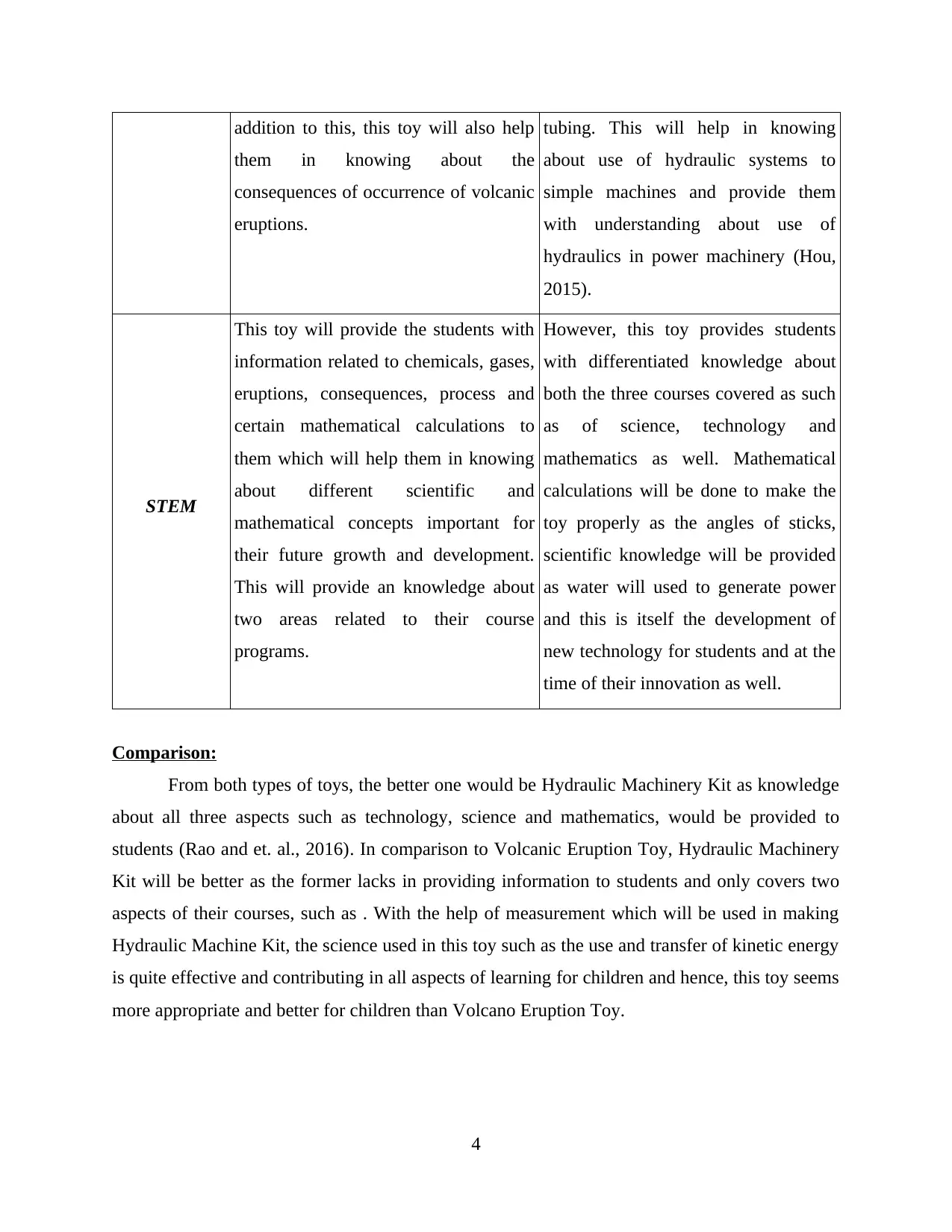
addition to this, this toy will also help
them in knowing about the
consequences of occurrence of volcanic
eruptions.
tubing. This will help in knowing
about use of hydraulic systems to
simple machines and provide them
with understanding about use of
hydraulics in power machinery (Hou,
2015).
STEM
This toy will provide the students with
information related to chemicals, gases,
eruptions, consequences, process and
certain mathematical calculations to
them which will help them in knowing
about different scientific and
mathematical concepts important for
their future growth and development.
This will provide an knowledge about
two areas related to their course
programs.
However, this toy provides students
with differentiated knowledge about
both the three courses covered as such
as of science, technology and
mathematics as well. Mathematical
calculations will be done to make the
toy properly as the angles of sticks,
scientific knowledge will be provided
as water will used to generate power
and this is itself the development of
new technology for students and at the
time of their innovation as well.
Comparison:
From both types of toys, the better one would be Hydraulic Machinery Kit as knowledge
about all three aspects such as technology, science and mathematics, would be provided to
students (Rao and et. al., 2016). In comparison to Volcanic Eruption Toy, Hydraulic Machinery
Kit will be better as the former lacks in providing information to students and only covers two
aspects of their courses, such as . With the help of measurement which will be used in making
Hydraulic Machine Kit, the science used in this toy such as the use and transfer of kinetic energy
is quite effective and contributing in all aspects of learning for children and hence, this toy seems
more appropriate and better for children than Volcano Eruption Toy.
4
them in knowing about the
consequences of occurrence of volcanic
eruptions.
tubing. This will help in knowing
about use of hydraulic systems to
simple machines and provide them
with understanding about use of
hydraulics in power machinery (Hou,
2015).
STEM
This toy will provide the students with
information related to chemicals, gases,
eruptions, consequences, process and
certain mathematical calculations to
them which will help them in knowing
about different scientific and
mathematical concepts important for
their future growth and development.
This will provide an knowledge about
two areas related to their course
programs.
However, this toy provides students
with differentiated knowledge about
both the three courses covered as such
as of science, technology and
mathematics as well. Mathematical
calculations will be done to make the
toy properly as the angles of sticks,
scientific knowledge will be provided
as water will used to generate power
and this is itself the development of
new technology for students and at the
time of their innovation as well.
Comparison:
From both types of toys, the better one would be Hydraulic Machinery Kit as knowledge
about all three aspects such as technology, science and mathematics, would be provided to
students (Rao and et. al., 2016). In comparison to Volcanic Eruption Toy, Hydraulic Machinery
Kit will be better as the former lacks in providing information to students and only covers two
aspects of their courses, such as . With the help of measurement which will be used in making
Hydraulic Machine Kit, the science used in this toy such as the use and transfer of kinetic energy
is quite effective and contributing in all aspects of learning for children and hence, this toy seems
more appropriate and better for children than Volcano Eruption Toy.
4
⊘ This is a preview!⊘
Do you want full access?
Subscribe today to unlock all pages.

Trusted by 1+ million students worldwide
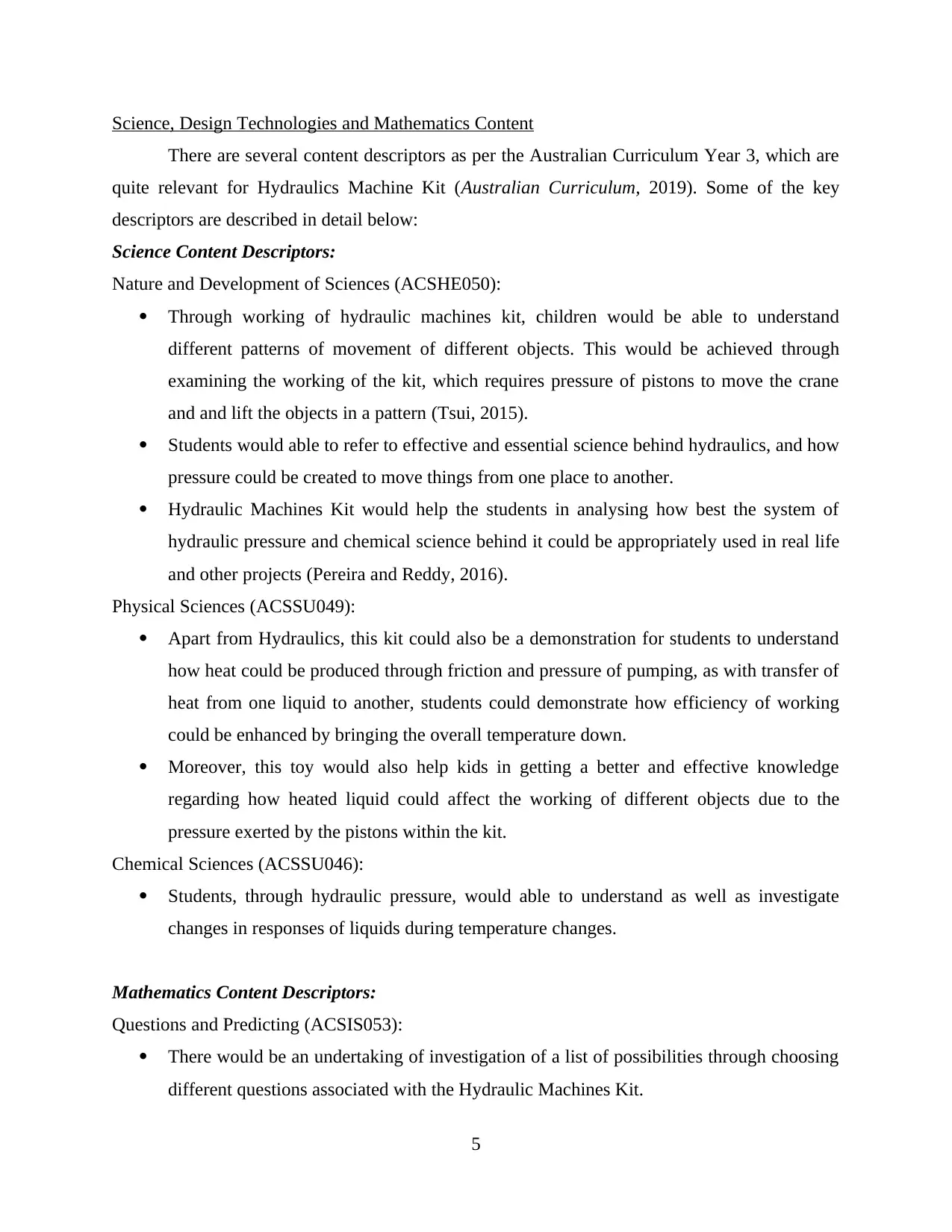
Science, Design Technologies and Mathematics Content
There are several content descriptors as per the Australian Curriculum Year 3, which are
quite relevant for Hydraulics Machine Kit (Australian Curriculum, 2019). Some of the key
descriptors are described in detail below:
Science Content Descriptors:
Nature and Development of Sciences (ACSHE050):
Through working of hydraulic machines kit, children would be able to understand
different patterns of movement of different objects. This would be achieved through
examining the working of the kit, which requires pressure of pistons to move the crane
and and lift the objects in a pattern (Tsui, 2015).
Students would able to refer to effective and essential science behind hydraulics, and how
pressure could be created to move things from one place to another.
Hydraulic Machines Kit would help the students in analysing how best the system of
hydraulic pressure and chemical science behind it could be appropriately used in real life
and other projects (Pereira and Reddy, 2016).
Physical Sciences (ACSSU049):
Apart from Hydraulics, this kit could also be a demonstration for students to understand
how heat could be produced through friction and pressure of pumping, as with transfer of
heat from one liquid to another, students could demonstrate how efficiency of working
could be enhanced by bringing the overall temperature down.
Moreover, this toy would also help kids in getting a better and effective knowledge
regarding how heated liquid could affect the working of different objects due to the
pressure exerted by the pistons within the kit.
Chemical Sciences (ACSSU046):
Students, through hydraulic pressure, would able to understand as well as investigate
changes in responses of liquids during temperature changes.
Mathematics Content Descriptors:
Questions and Predicting (ACSIS053):
There would be an undertaking of investigation of a list of possibilities through choosing
different questions associated with the Hydraulic Machines Kit.
5
There are several content descriptors as per the Australian Curriculum Year 3, which are
quite relevant for Hydraulics Machine Kit (Australian Curriculum, 2019). Some of the key
descriptors are described in detail below:
Science Content Descriptors:
Nature and Development of Sciences (ACSHE050):
Through working of hydraulic machines kit, children would be able to understand
different patterns of movement of different objects. This would be achieved through
examining the working of the kit, which requires pressure of pistons to move the crane
and and lift the objects in a pattern (Tsui, 2015).
Students would able to refer to effective and essential science behind hydraulics, and how
pressure could be created to move things from one place to another.
Hydraulic Machines Kit would help the students in analysing how best the system of
hydraulic pressure and chemical science behind it could be appropriately used in real life
and other projects (Pereira and Reddy, 2016).
Physical Sciences (ACSSU049):
Apart from Hydraulics, this kit could also be a demonstration for students to understand
how heat could be produced through friction and pressure of pumping, as with transfer of
heat from one liquid to another, students could demonstrate how efficiency of working
could be enhanced by bringing the overall temperature down.
Moreover, this toy would also help kids in getting a better and effective knowledge
regarding how heated liquid could affect the working of different objects due to the
pressure exerted by the pistons within the kit.
Chemical Sciences (ACSSU046):
Students, through hydraulic pressure, would able to understand as well as investigate
changes in responses of liquids during temperature changes.
Mathematics Content Descriptors:
Questions and Predicting (ACSIS053):
There would be an undertaking of investigation of a list of possibilities through choosing
different questions associated with the Hydraulic Machines Kit.
5
Paraphrase This Document
Need a fresh take? Get an instant paraphrase of this document with our AI Paraphraser
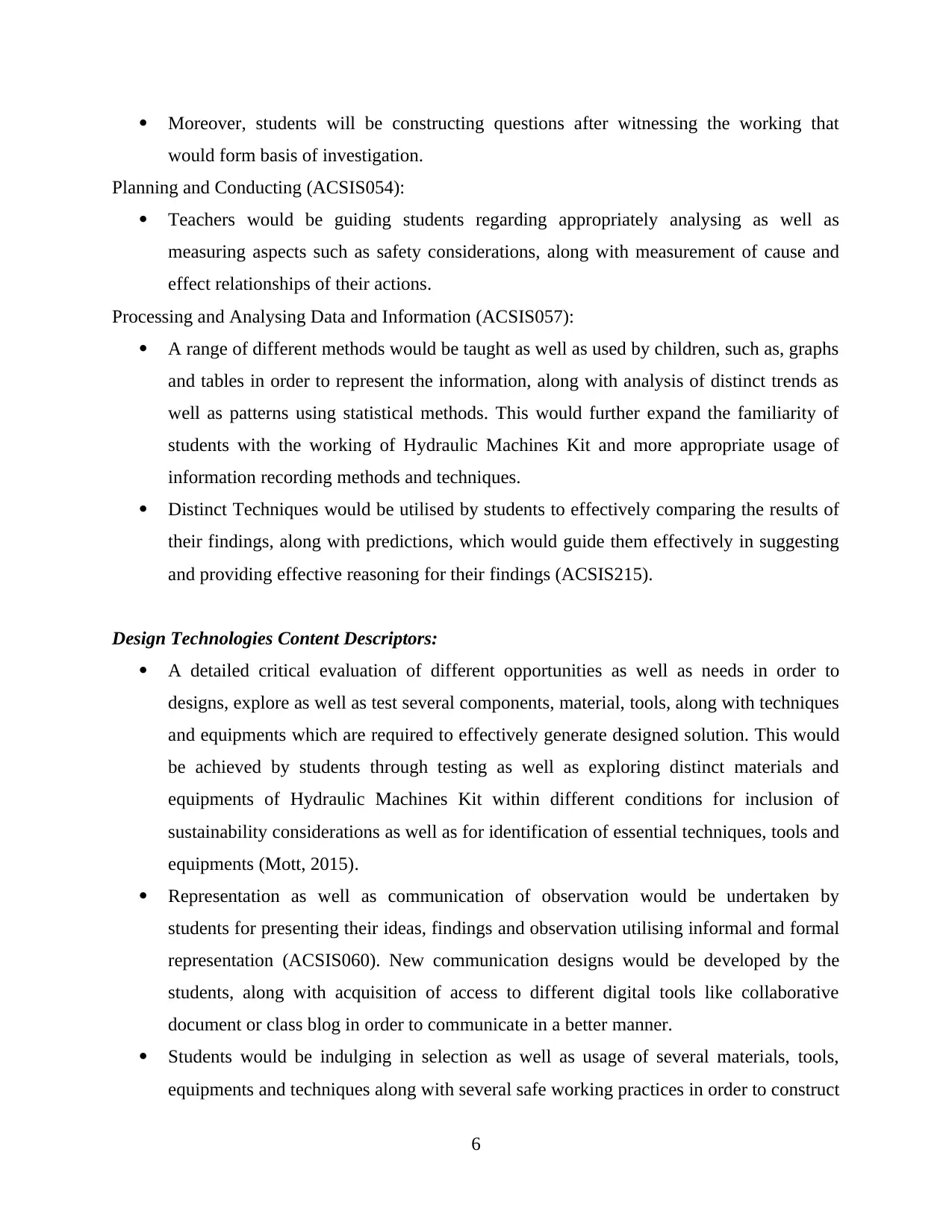
Moreover, students will be constructing questions after witnessing the working that
would form basis of investigation.
Planning and Conducting (ACSIS054):
Teachers would be guiding students regarding appropriately analysing as well as
measuring aspects such as safety considerations, along with measurement of cause and
effect relationships of their actions.
Processing and Analysing Data and Information (ACSIS057):
A range of different methods would be taught as well as used by children, such as, graphs
and tables in order to represent the information, along with analysis of distinct trends as
well as patterns using statistical methods. This would further expand the familiarity of
students with the working of Hydraulic Machines Kit and more appropriate usage of
information recording methods and techniques.
Distinct Techniques would be utilised by students to effectively comparing the results of
their findings, along with predictions, which would guide them effectively in suggesting
and providing effective reasoning for their findings (ACSIS215).
Design Technologies Content Descriptors:
A detailed critical evaluation of different opportunities as well as needs in order to
designs, explore as well as test several components, material, tools, along with techniques
and equipments which are required to effectively generate designed solution. This would
be achieved by students through testing as well as exploring distinct materials and
equipments of Hydraulic Machines Kit within different conditions for inclusion of
sustainability considerations as well as for identification of essential techniques, tools and
equipments (Mott, 2015).
Representation as well as communication of observation would be undertaken by
students for presenting their ideas, findings and observation utilising informal and formal
representation (ACSIS060). New communication designs would be developed by the
students, along with acquisition of access to different digital tools like collaborative
document or class blog in order to communicate in a better manner.
Students would be indulging in selection as well as usage of several materials, tools,
equipments and techniques along with several safe working practices in order to construct
6
would form basis of investigation.
Planning and Conducting (ACSIS054):
Teachers would be guiding students regarding appropriately analysing as well as
measuring aspects such as safety considerations, along with measurement of cause and
effect relationships of their actions.
Processing and Analysing Data and Information (ACSIS057):
A range of different methods would be taught as well as used by children, such as, graphs
and tables in order to represent the information, along with analysis of distinct trends as
well as patterns using statistical methods. This would further expand the familiarity of
students with the working of Hydraulic Machines Kit and more appropriate usage of
information recording methods and techniques.
Distinct Techniques would be utilised by students to effectively comparing the results of
their findings, along with predictions, which would guide them effectively in suggesting
and providing effective reasoning for their findings (ACSIS215).
Design Technologies Content Descriptors:
A detailed critical evaluation of different opportunities as well as needs in order to
designs, explore as well as test several components, material, tools, along with techniques
and equipments which are required to effectively generate designed solution. This would
be achieved by students through testing as well as exploring distinct materials and
equipments of Hydraulic Machines Kit within different conditions for inclusion of
sustainability considerations as well as for identification of essential techniques, tools and
equipments (Mott, 2015).
Representation as well as communication of observation would be undertaken by
students for presenting their ideas, findings and observation utilising informal and formal
representation (ACSIS060). New communication designs would be developed by the
students, along with acquisition of access to different digital tools like collaborative
document or class blog in order to communicate in a better manner.
Students would be indulging in selection as well as usage of several materials, tools,
equipments and techniques along with several safe working practices in order to construct
6
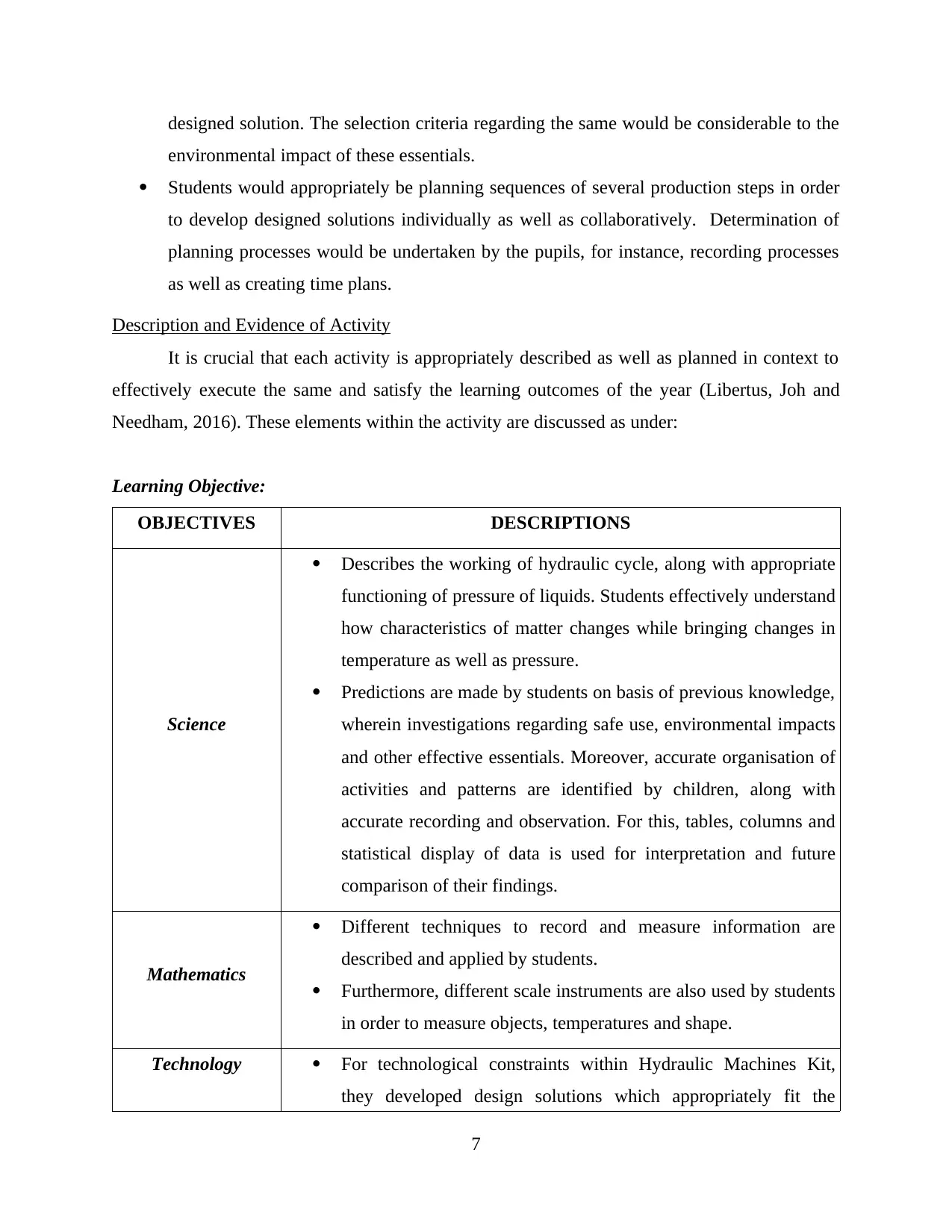
designed solution. The selection criteria regarding the same would be considerable to the
environmental impact of these essentials.
Students would appropriately be planning sequences of several production steps in order
to develop designed solutions individually as well as collaboratively. Determination of
planning processes would be undertaken by the pupils, for instance, recording processes
as well as creating time plans.
Description and Evidence of Activity
It is crucial that each activity is appropriately described as well as planned in context to
effectively execute the same and satisfy the learning outcomes of the year (Libertus, Joh and
Needham, 2016). These elements within the activity are discussed as under:
Learning Objective:
OBJECTIVES DESCRIPTIONS
Science
Describes the working of hydraulic cycle, along with appropriate
functioning of pressure of liquids. Students effectively understand
how characteristics of matter changes while bringing changes in
temperature as well as pressure.
Predictions are made by students on basis of previous knowledge,
wherein investigations regarding safe use, environmental impacts
and other effective essentials. Moreover, accurate organisation of
activities and patterns are identified by children, along with
accurate recording and observation. For this, tables, columns and
statistical display of data is used for interpretation and future
comparison of their findings.
Mathematics
Different techniques to record and measure information are
described and applied by students.
Furthermore, different scale instruments are also used by students
in order to measure objects, temperatures and shape.
Technology For technological constraints within Hydraulic Machines Kit,
they developed design solutions which appropriately fit the
7
environmental impact of these essentials.
Students would appropriately be planning sequences of several production steps in order
to develop designed solutions individually as well as collaboratively. Determination of
planning processes would be undertaken by the pupils, for instance, recording processes
as well as creating time plans.
Description and Evidence of Activity
It is crucial that each activity is appropriately described as well as planned in context to
effectively execute the same and satisfy the learning outcomes of the year (Libertus, Joh and
Needham, 2016). These elements within the activity are discussed as under:
Learning Objective:
OBJECTIVES DESCRIPTIONS
Science
Describes the working of hydraulic cycle, along with appropriate
functioning of pressure of liquids. Students effectively understand
how characteristics of matter changes while bringing changes in
temperature as well as pressure.
Predictions are made by students on basis of previous knowledge,
wherein investigations regarding safe use, environmental impacts
and other effective essentials. Moreover, accurate organisation of
activities and patterns are identified by children, along with
accurate recording and observation. For this, tables, columns and
statistical display of data is used for interpretation and future
comparison of their findings.
Mathematics
Different techniques to record and measure information are
described and applied by students.
Furthermore, different scale instruments are also used by students
in order to measure objects, temperatures and shape.
Technology For technological constraints within Hydraulic Machines Kit,
they developed design solutions which appropriately fit the
7
⊘ This is a preview!⊘
Do you want full access?
Subscribe today to unlock all pages.

Trusted by 1+ million students worldwide
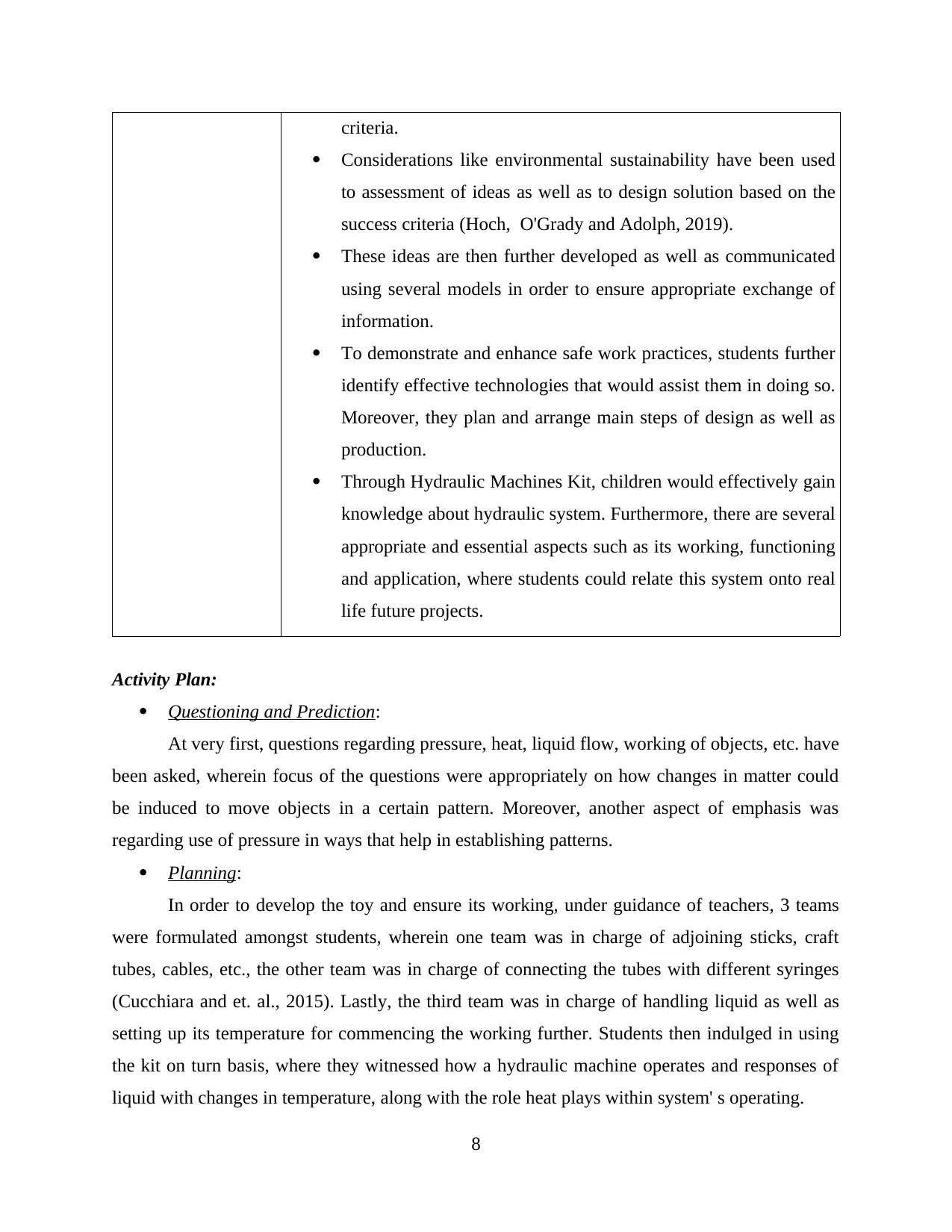
criteria.
Considerations like environmental sustainability have been used
to assessment of ideas as well as to design solution based on the
success criteria (Hoch, O'Grady and Adolph, 2019).
These ideas are then further developed as well as communicated
using several models in order to ensure appropriate exchange of
information.
To demonstrate and enhance safe work practices, students further
identify effective technologies that would assist them in doing so.
Moreover, they plan and arrange main steps of design as well as
production.
Through Hydraulic Machines Kit, children would effectively gain
knowledge about hydraulic system. Furthermore, there are several
appropriate and essential aspects such as its working, functioning
and application, where students could relate this system onto real
life future projects.
Activity Plan:
Questioning and Prediction:
At very first, questions regarding pressure, heat, liquid flow, working of objects, etc. have
been asked, wherein focus of the questions were appropriately on how changes in matter could
be induced to move objects in a certain pattern. Moreover, another aspect of emphasis was
regarding use of pressure in ways that help in establishing patterns.
Planning:
In order to develop the toy and ensure its working, under guidance of teachers, 3 teams
were formulated amongst students, wherein one team was in charge of adjoining sticks, craft
tubes, cables, etc., the other team was in charge of connecting the tubes with different syringes
(Cucchiara and et. al., 2015). Lastly, the third team was in charge of handling liquid as well as
setting up its temperature for commencing the working further. Students then indulged in using
the kit on turn basis, where they witnessed how a hydraulic machine operates and responses of
liquid with changes in temperature, along with the role heat plays within system' s operating.
8
Considerations like environmental sustainability have been used
to assessment of ideas as well as to design solution based on the
success criteria (Hoch, O'Grady and Adolph, 2019).
These ideas are then further developed as well as communicated
using several models in order to ensure appropriate exchange of
information.
To demonstrate and enhance safe work practices, students further
identify effective technologies that would assist them in doing so.
Moreover, they plan and arrange main steps of design as well as
production.
Through Hydraulic Machines Kit, children would effectively gain
knowledge about hydraulic system. Furthermore, there are several
appropriate and essential aspects such as its working, functioning
and application, where students could relate this system onto real
life future projects.
Activity Plan:
Questioning and Prediction:
At very first, questions regarding pressure, heat, liquid flow, working of objects, etc. have
been asked, wherein focus of the questions were appropriately on how changes in matter could
be induced to move objects in a certain pattern. Moreover, another aspect of emphasis was
regarding use of pressure in ways that help in establishing patterns.
Planning:
In order to develop the toy and ensure its working, under guidance of teachers, 3 teams
were formulated amongst students, wherein one team was in charge of adjoining sticks, craft
tubes, cables, etc., the other team was in charge of connecting the tubes with different syringes
(Cucchiara and et. al., 2015). Lastly, the third team was in charge of handling liquid as well as
setting up its temperature for commencing the working further. Students then indulged in using
the kit on turn basis, where they witnessed how a hydraulic machine operates and responses of
liquid with changes in temperature, along with the role heat plays within system' s operating.
8
Paraphrase This Document
Need a fresh take? Get an instant paraphrase of this document with our AI Paraphraser
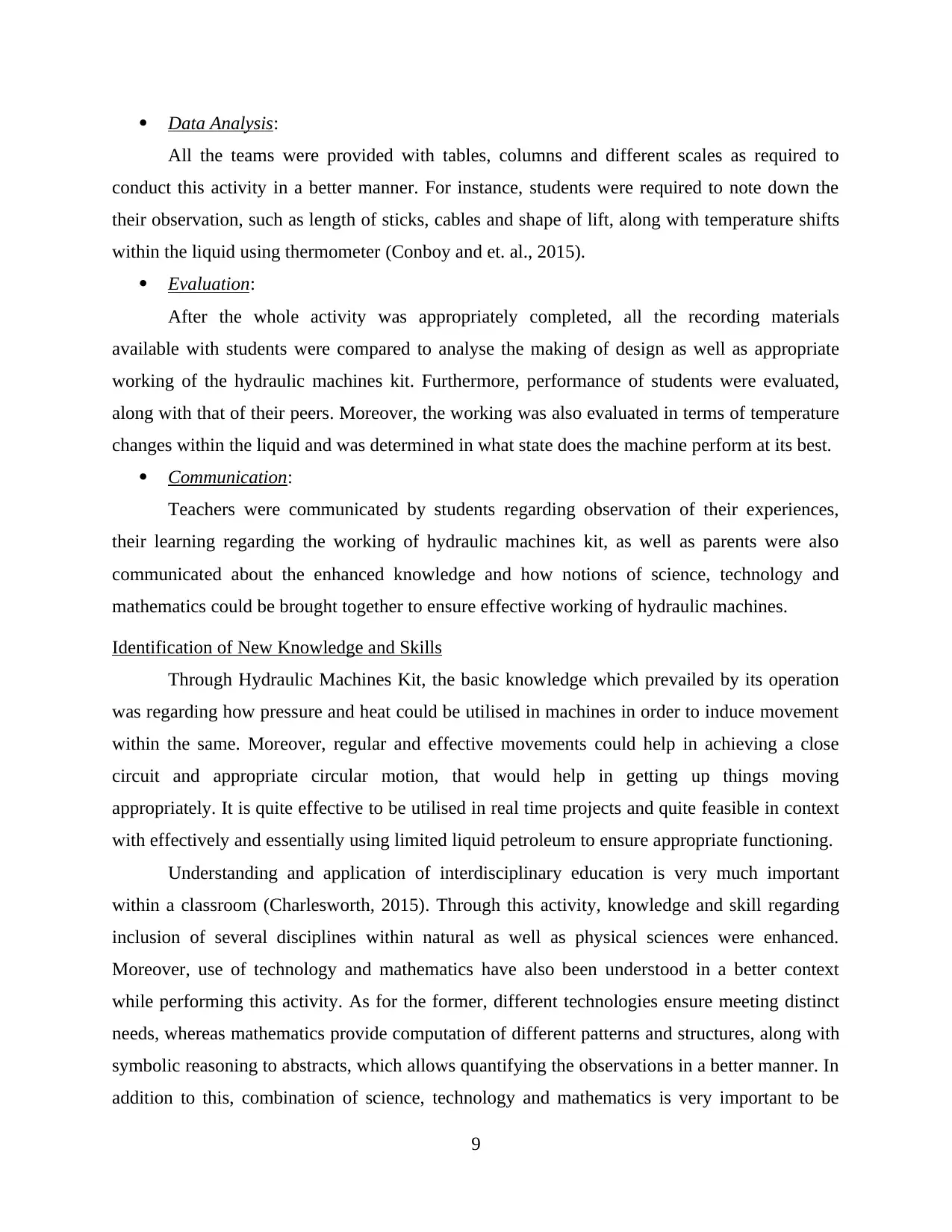
Data Analysis:
All the teams were provided with tables, columns and different scales as required to
conduct this activity in a better manner. For instance, students were required to note down the
their observation, such as length of sticks, cables and shape of lift, along with temperature shifts
within the liquid using thermometer (Conboy and et. al., 2015).
Evaluation:
After the whole activity was appropriately completed, all the recording materials
available with students were compared to analyse the making of design as well as appropriate
working of the hydraulic machines kit. Furthermore, performance of students were evaluated,
along with that of their peers. Moreover, the working was also evaluated in terms of temperature
changes within the liquid and was determined in what state does the machine perform at its best.
Communication:
Teachers were communicated by students regarding observation of their experiences,
their learning regarding the working of hydraulic machines kit, as well as parents were also
communicated about the enhanced knowledge and how notions of science, technology and
mathematics could be brought together to ensure effective working of hydraulic machines.
Identification of New Knowledge and Skills
Through Hydraulic Machines Kit, the basic knowledge which prevailed by its operation
was regarding how pressure and heat could be utilised in machines in order to induce movement
within the same. Moreover, regular and effective movements could help in achieving a close
circuit and appropriate circular motion, that would help in getting up things moving
appropriately. It is quite effective to be utilised in real time projects and quite feasible in context
with effectively and essentially using limited liquid petroleum to ensure appropriate functioning.
Understanding and application of interdisciplinary education is very much important
within a classroom (Charlesworth, 2015). Through this activity, knowledge and skill regarding
inclusion of several disciplines within natural as well as physical sciences were enhanced.
Moreover, use of technology and mathematics have also been understood in a better context
while performing this activity. As for the former, different technologies ensure meeting distinct
needs, whereas mathematics provide computation of different patterns and structures, along with
symbolic reasoning to abstracts, which allows quantifying the observations in a better manner. In
addition to this, combination of science, technology and mathematics is very important to be
9
All the teams were provided with tables, columns and different scales as required to
conduct this activity in a better manner. For instance, students were required to note down the
their observation, such as length of sticks, cables and shape of lift, along with temperature shifts
within the liquid using thermometer (Conboy and et. al., 2015).
Evaluation:
After the whole activity was appropriately completed, all the recording materials
available with students were compared to analyse the making of design as well as appropriate
working of the hydraulic machines kit. Furthermore, performance of students were evaluated,
along with that of their peers. Moreover, the working was also evaluated in terms of temperature
changes within the liquid and was determined in what state does the machine perform at its best.
Communication:
Teachers were communicated by students regarding observation of their experiences,
their learning regarding the working of hydraulic machines kit, as well as parents were also
communicated about the enhanced knowledge and how notions of science, technology and
mathematics could be brought together to ensure effective working of hydraulic machines.
Identification of New Knowledge and Skills
Through Hydraulic Machines Kit, the basic knowledge which prevailed by its operation
was regarding how pressure and heat could be utilised in machines in order to induce movement
within the same. Moreover, regular and effective movements could help in achieving a close
circuit and appropriate circular motion, that would help in getting up things moving
appropriately. It is quite effective to be utilised in real time projects and quite feasible in context
with effectively and essentially using limited liquid petroleum to ensure appropriate functioning.
Understanding and application of interdisciplinary education is very much important
within a classroom (Charlesworth, 2015). Through this activity, knowledge and skill regarding
inclusion of several disciplines within natural as well as physical sciences were enhanced.
Moreover, use of technology and mathematics have also been understood in a better context
while performing this activity. As for the former, different technologies ensure meeting distinct
needs, whereas mathematics provide computation of different patterns and structures, along with
symbolic reasoning to abstracts, which allows quantifying the observations in a better manner. In
addition to this, combination of science, technology and mathematics is very important to be
9
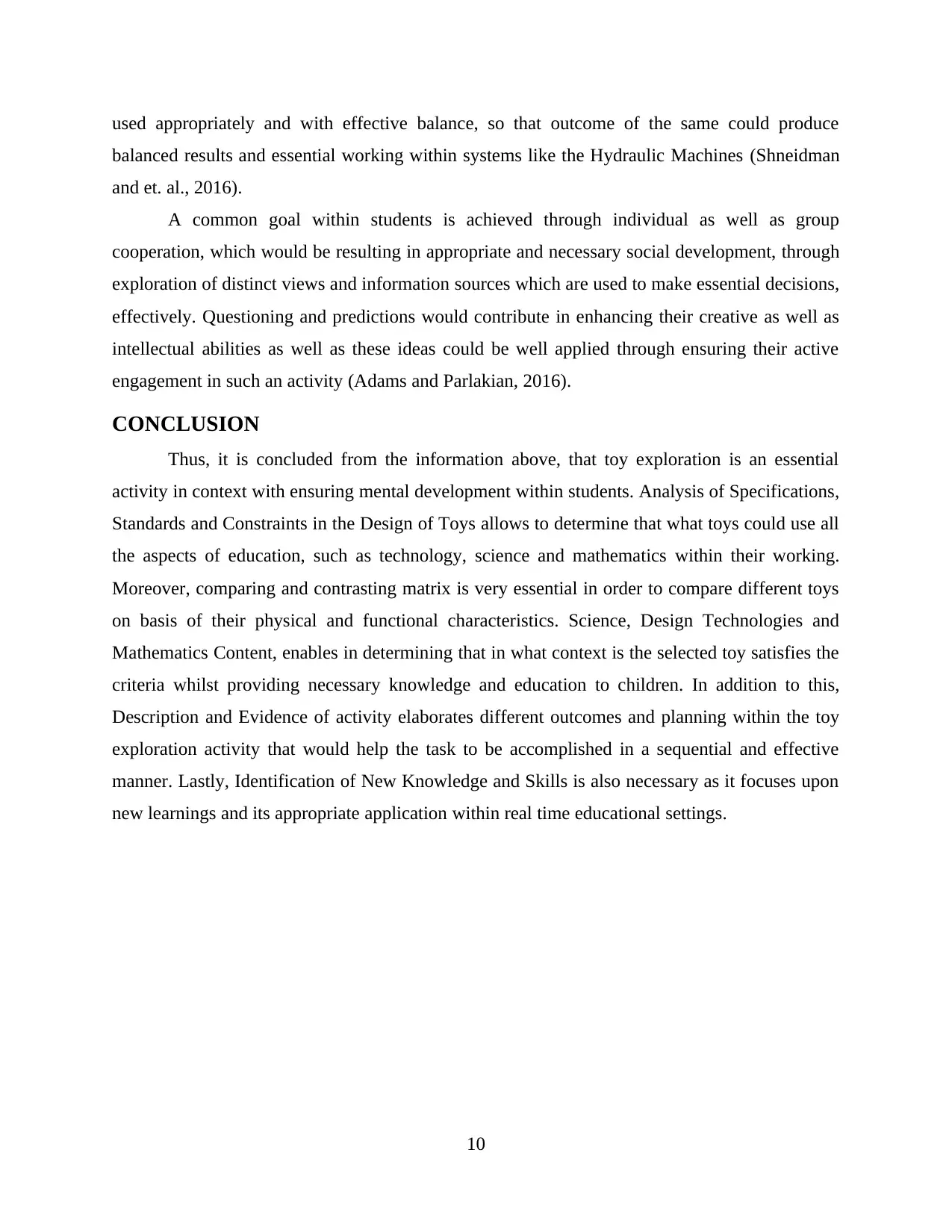
used appropriately and with effective balance, so that outcome of the same could produce
balanced results and essential working within systems like the Hydraulic Machines (Shneidman
and et. al., 2016).
A common goal within students is achieved through individual as well as group
cooperation, which would be resulting in appropriate and necessary social development, through
exploration of distinct views and information sources which are used to make essential decisions,
effectively. Questioning and predictions would contribute in enhancing their creative as well as
intellectual abilities as well as these ideas could be well applied through ensuring their active
engagement in such an activity (Adams and Parlakian, 2016).
CONCLUSION
Thus, it is concluded from the information above, that toy exploration is an essential
activity in context with ensuring mental development within students. Analysis of Specifications,
Standards and Constraints in the Design of Toys allows to determine that what toys could use all
the aspects of education, such as technology, science and mathematics within their working.
Moreover, comparing and contrasting matrix is very essential in order to compare different toys
on basis of their physical and functional characteristics. Science, Design Technologies and
Mathematics Content, enables in determining that in what context is the selected toy satisfies the
criteria whilst providing necessary knowledge and education to children. In addition to this,
Description and Evidence of activity elaborates different outcomes and planning within the toy
exploration activity that would help the task to be accomplished in a sequential and effective
manner. Lastly, Identification of New Knowledge and Skills is also necessary as it focuses upon
new learnings and its appropriate application within real time educational settings.
10
balanced results and essential working within systems like the Hydraulic Machines (Shneidman
and et. al., 2016).
A common goal within students is achieved through individual as well as group
cooperation, which would be resulting in appropriate and necessary social development, through
exploration of distinct views and information sources which are used to make essential decisions,
effectively. Questioning and predictions would contribute in enhancing their creative as well as
intellectual abilities as well as these ideas could be well applied through ensuring their active
engagement in such an activity (Adams and Parlakian, 2016).
CONCLUSION
Thus, it is concluded from the information above, that toy exploration is an essential
activity in context with ensuring mental development within students. Analysis of Specifications,
Standards and Constraints in the Design of Toys allows to determine that what toys could use all
the aspects of education, such as technology, science and mathematics within their working.
Moreover, comparing and contrasting matrix is very essential in order to compare different toys
on basis of their physical and functional characteristics. Science, Design Technologies and
Mathematics Content, enables in determining that in what context is the selected toy satisfies the
criteria whilst providing necessary knowledge and education to children. In addition to this,
Description and Evidence of activity elaborates different outcomes and planning within the toy
exploration activity that would help the task to be accomplished in a sequential and effective
manner. Lastly, Identification of New Knowledge and Skills is also necessary as it focuses upon
new learnings and its appropriate application within real time educational settings.
10
⊘ This is a preview!⊘
Do you want full access?
Subscribe today to unlock all pages.

Trusted by 1+ million students worldwide
1 out of 14
Related Documents
Your All-in-One AI-Powered Toolkit for Academic Success.
+13062052269
info@desklib.com
Available 24*7 on WhatsApp / Email
![[object Object]](/_next/static/media/star-bottom.7253800d.svg)
Unlock your academic potential
Copyright © 2020–2025 A2Z Services. All Rights Reserved. Developed and managed by ZUCOL.




